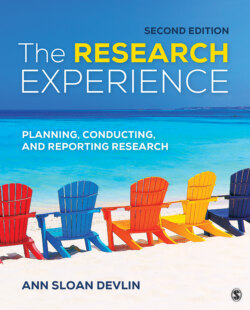Читать книгу The Research Experience - Ann Sloan Devlin - Страница 73
На сайте Литреса книга снята с продажи.
How Journals Differ: Issues Related to Quality
ОглавлениеJournals differ from each other in many ways, from the number of issues they publish each year to their standards of acceptance and their impact factor, which is a number that reflects the average number of times articles from a specific journal have been cited over a particular period of time (e.g., 2 years or 5 years). This impact measure is considered by some to be a proxy for the importance of the journal. You can usually find the impact factor for a given journal on its home page. The Journal Citation Reports (JCR), published by Thomson Reuters, lists journals and their associated impact factor. Access to this report requires a subscription, which your institution may have.
Impact factor: Number that reflects the average number of times articles from a particular journal have been cited over a particular period of time (e.g., 2 years).
To understand better the differences in journal quality you might encounter, it might be helpful to contrast the scope and depth of the articles in such journals as The Journal of College and University Student Housing with those in such periodicals as the Journal of Personality and Social Psychology (JPSP) or the Journal of Applied Psychology. Arguably these journals differ with regard to the sophistication and complexity of work each publishes. JPSP and the Journal of Applied Psychology are among the premier journals in psychology in terms of the quality of the articles, with high rejection rates, which some interpret as an indicator of quality. An article on the operation of journals published by the American Psychological Association in 2017 listed the rejection rate for the Journal of Applied Psychology at 88%, which was one of the highest for any of the APA journals listed; the Journal of Educational Psychology topped the list at 90% (https://www.apa.org/pubs/journals/features/2016-statistics.pdf).
The articles in JPSP and the Journal of Applied Psychology often contain a series of experiments, many participants, advanced kinds of analyses, and extramural funding. In contrast, The Journal of College and University Student Housing (published twice a year) typically contains research of more modest proportions, in terms of scope. The articles are often single studies of narrow scope with less advanced statistical analyses. A paper from the second issue of the 2015 publication of The Journal of College and University Student Housing illustrates these characterizations. “Is Three a Crowd? Exploring the Development and Satisfaction of Students in Triples” (Long & Kujawa, 2015) was conducted at one institution, focused on a fairly narrow topic, and used analysis of variance and chi-square as the primary statistical approaches. In contrast, a paper by Mann and Ferguson (2014), “Can We Undo Our First Impressions? The Role of Reinterpretation in Reversing Implicit Evaluations,” published in JPSP, presented seven experiments and was funded by grants from the National Institutes of Health (NIH) and a National Science Foundation (NSF) Graduate Research Fellowship award. The research used mediational analyses, as well as a mixed design (both between- and within-subjects factors; see Chapter 10).
Journals differ in the criteria used to determine research that is likely to be (a) accepted for review and (b) published in a particular journal. Nevertheless, it is worth remembering that journal impact is not synonymous with journal quality. Remembering Meltzoff’s (1998) comments about the importance of critical reading, mentioned in Chapter 1, every journal article needs to be approached with the attitude “show me.” We should not exhibit an overreliance on authorities, one of the logical problems in thinking (Shermer, 1997) discussed in Chapter 1, and assume that a high rejection rate = high quality.
